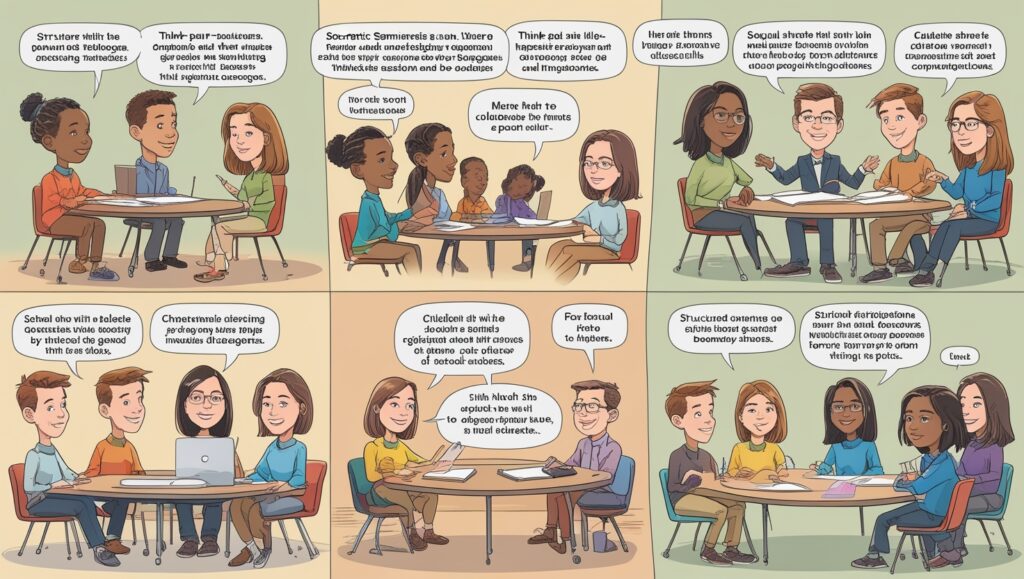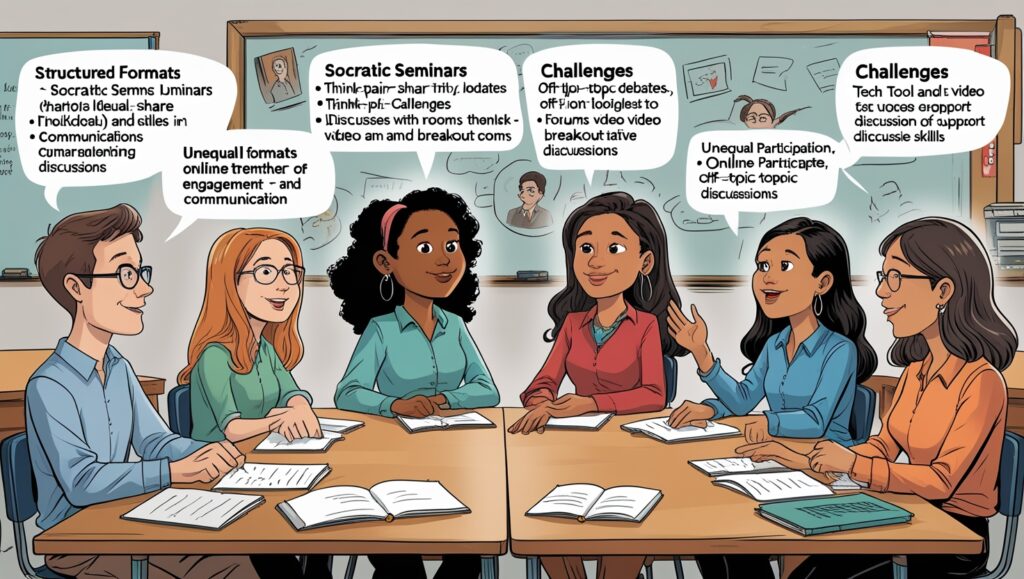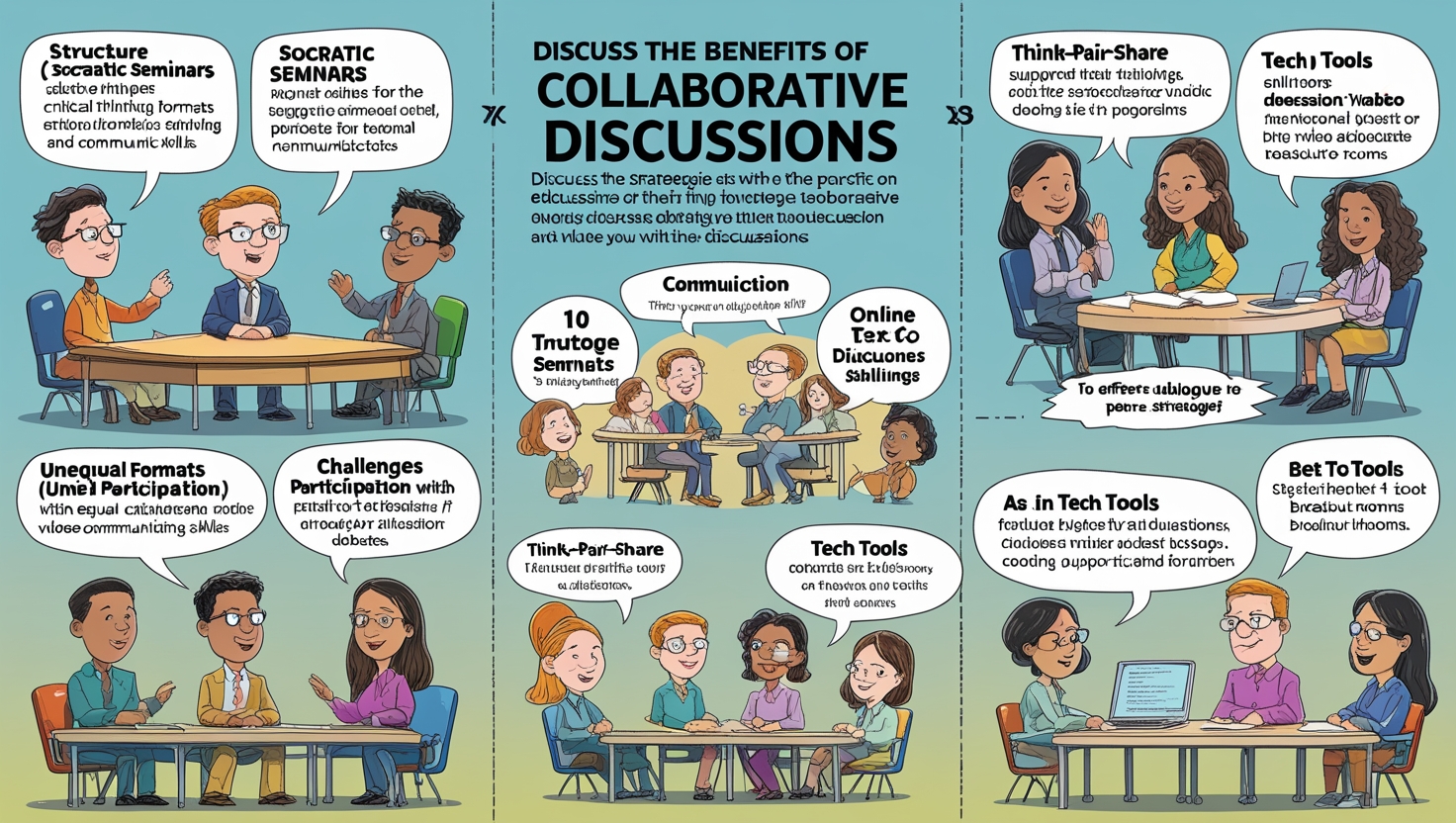Introduction
The Power of Collaborative Discussions in Education, Education is no longer confined to traditional lecture-based teaching methods. In modern pedagogy, collaborative discussions have emerged as a powerful tool for enhancing student engagement, critical thinking, and deeper learning. Collaborative discussions involve structured conversations where students actively exchange ideas, challenge perspectives, and co-construct knowledge. This approach aligns with social constructivist theories, which emphasize that learning is most effective when students interact with peers and instructors in meaningful dialogue.
This article explores the benefits, strategies, challenges, and best practices of implementing collaborative discussions in educational settings. It also examines how technology can facilitate these discussions and provides practical tips for educators to maximize their effectiveness.
The Benefits of Collaborative Discussions in Education
1. Enhances Critical Thinking and Problem-Solving Skills
When students engage in discussions, they must articulate their thoughts, defend their viewpoints, and consider alternative perspectives. This process strengthens analytical reasoning and helps learners evaluate information more effectively.
2. Promotes Active Learning and Engagement
Unlike passive listening, collaborative discussions require students to participate actively. This leads to higher retention rates and a deeper understanding of the subject matter.
3. Develops Communication and Social Skills
Through structured dialogue, students improve their verbal communication, listening skills, and empathy. These skills are essential for academic success and future career readiness.
4. Encourages Diverse Perspectives
Classrooms are increasingly diverse, and collaborative discussions allow students to share cultural, social, and personal viewpoints, fostering inclusivity and mutual respect.
5. Builds Confidence and Leadership Abilities
Students who regularly participate in discussions gain confidence in expressing their ideas. Some may naturally take on leadership roles by facilitating conversations or mediating disagreements.

Strategies for Effective Collaborative Discussions
To ensure productive discussions, educators should implement structured strategies:
1. Establish Clear Objectives
Before starting a discussion, teachers should define learning goals (e.g., analyzing a text, debating a topic, solving a problem). Clear objectives keep conversations focused.
2. Use Structured Formats
- Think-Pair-Share: Students reflect individually, discuss in pairs, then share with the class.
- Socratic Seminars: Open-ended questions guide deep, student-led discussions.
- Fishbowl Discussions: A small group debates while others observe and later provide feedback.
3. Set Discussion Norms
Establishing ground rules (e.g., respectful listening, no interruptions, evidence-based arguments) ensures a safe and productive environment.
4. Assign Roles
To keep discussions organized, assign roles such as:
- Facilitator (guides the conversation)
- Timekeeper (ensures equal participation)
- Note-taker (summarizes key points)
5. Incorporate Scaffolding Techniques
- Provide sentence starters (“I agree because…”, “Another perspective is…”)
- Use graphic organizers to help students structure their thoughts.

Challenges and Solutions in Collaborative Discussions
Despite their benefits, collaborative discussions can face obstacles:
1. Unequal Participation
Problem: Some students dominate while others remain silent.
Solution: Use round-robin sharing or digital tools (like polling apps) to ensure everyone contributes.
2. Off-Topic Conversations
Problem: Discussions may stray from the main topic.
Solution: The facilitator should gently redirect using probing questions.
3. Conflict and Miscommunication
Problem: Disagreements can become unproductive.
Solution: Teach active listening and conflict-resolution strategies.
4. Time Constraints
Problem: Discussions may run too long or too short.
Solution: Set clear time limits and adjust based on student engagement.
The Role of Technology in Collaborative Discussions
Digital tools can enhance discussions by:
1. Online Discussion Forums (e.g., Google Classroom, Padlet, Flip)
- Allow asynchronous participation, giving quieter students a voice.
- Enable threaded discussions for deeper exploration of topics.
2. Video Conferencing (Zoom, Microsoft Teams Breakout Rooms)
- Facilitate small-group discussions in virtual classrooms.
- Include interactive features like polls and whiteboards.
3. AI and Chatbots
- AI-driven tools (e.g., ChatGPT for debate prep) can simulate discussions.
- Provide instant feedback on student arguments.
Best Practices for Educators
- Model Effective Discussions – Demonstrate how to ask open-ended questions and build on others’ ideas.
- Encourage Reflective Thinking – Have students journal about what they learned from discussions.
- Assess Participation Thoughtfully – Use rubrics that evaluate quality of contributions, not just quantity.
- Foster a Growth Mindset – Emphasize that discussions are about learning, not just being “right.”
Conclusion
Collaborative discussions transform classrooms into dynamic, interactive learning spaces where students develop essential academic and social-emotional skills. By implementing structured strategies, leveraging technology, and addressing challenges proactively, educators can maximize the impact of discussions.
As education continues to evolve, fostering student voice and collaboration will remain a cornerstone of effective teaching. Whether in-person or online, meaningful discussions empower learners to think critically, communicate effectively, and engage deeply with content—preparing them for success beyond the classroom.


escort kuşadası Kuşadası escort hizmetleri, bu büyüleyici atmosferde tatilcilere profesyonel companionship sunarak, gecelerinizi özel kılıyor. https://zephyrzest.com/
I’ve been looking for info like this—glad I found your blog.
маркетплейс аккаунтов услуги по продаже аккаунтов
I think this is one of the most vital information for me. And i am glad reading your article. But wanna remark on few general things, The site style is ideal, the articles is really great : D. Good job, cheers
Особенности функционирования Кракена кракен фургон
Кракен kra34.cc‚ как и другие крупные торговые площадки Даркнета кракен вход‚ имеет сложную структуру и механизмы функционирования. Одной из ключевых особенностей является использование криптовалют для осуществления транзакций. Это позволяет сохранять анонимность и обеспечивает удобство для пользователей.
Механизмы безопасности и анонимности
Для обеспечения безопасности и анонимности пользователей‚ кракен фургон использует различные методы шифрования и механизмы защиты данных. Это включает в себя:
Шифрование данных: Все данные‚ передаваемые через площадку кракен сайт‚ шифруются с использованием современных алгоритмов шифрования.
Использование кра32сс: Кракен доступен через сеть Tor‚ что обеспечивает анонимность и защищает личность пользователей.
Многофакторная аутентификация: Для дополнительной защиты учетных записей пользователей kra31.cc используется многофакторная аутентификация.
Взаимодействие с пользователями и поддержка
Кракен уделяет внимание взаимодействию с пользователями и предлагает различные механизмы поддержки. Это включает в себя:
Системы обратной связи: Пользователи кра32сс могут оставлять отзывы и оценки продавцам‚ что помогает поддерживать качество услуг на площадке.
Техническая поддержка: Кракен предлагает техническую поддержку для решения проблем и вопросов‚ возникающих у пользователей.
Перспективы и вызовы
Будущее кра32‚ как и других торговых площадок кракен тор Даркнета‚ зависит от различных факторов‚ включая изменения в законодательстве‚ развитие технологий и давление со стороны правоохранительных органов. Несмотря на вызовы‚ Кракен продолжает оставаться одной из наиболее известных и используемых kra30.at площадок в Даркнете.